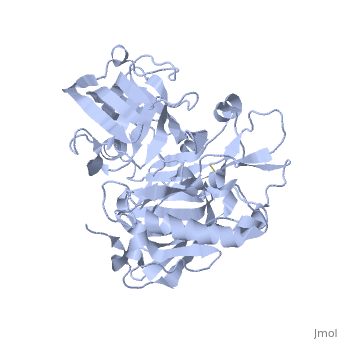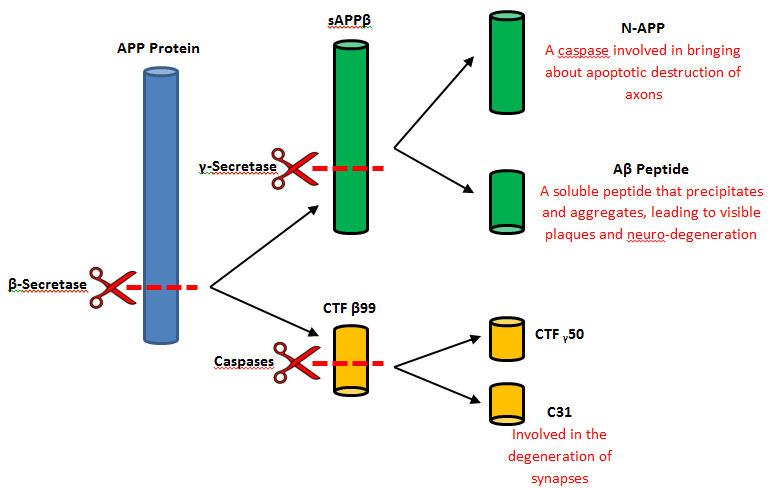Beta Secretase (BACE1) 1SGZ
From Proteopedia
| Line 56: | Line 56: | ||
== Inhibitors == | == Inhibitors == | ||
| - | In recent years there has been much work done with beta-secretase inhibitors and synthesizing therapeutic drugs that will inhibit the production of beta-amyloids. An area that has specifically been studied is Beta-secretase processing of APP. Processing of APP is the first step in the synthesis of amyloid-beta, and therefore inhibiting it could be a successful way to inhibit the development of Alzheimer's diseases<ref name="sixteen">Thompson, L.; Bronson, J.; Zusi, C.; Progress in the discovery of BACE Inhibitors. Current Pharmaceutical design. 2005, 11, 3383-3404</ref>. Two main types of beta-secretase inhibitors that are being studied include; peptidomimetic beta-secretase inhibitors and nonpeptidomimetic beta-secretase inhibitors. | + | In recent years there has been much work done with beta-secretase inhibitors and synthesizing therapeutic drugs that will inhibit the production of beta-amyloids. An area that has specifically been studied is Beta-secretase processing of APP. Processing of APP is the first step in the synthesis of amyloid-beta, and therefore inhibiting it could be a successful way to inhibit the development of Alzheimer's diseases<ref name="sixteen">Thompson, L.; Bronson, J.; Zusi, C.; Progress in the discovery of BACE Inhibitors. Current Pharmaceutical design. 2005, 11, 3383-3404</ref>. Two main types of beta-secretase inhibitors that are being studied include; peptidomimetic beta-secretase inhibitors and nonpeptidomimetic beta-secretase inhibitors<ref name="seventeen">Ghosh, A. K.; Brindisi, M.; Tang, J. Developing β-Secretase Inhibitors for Treatment of Alzheimer’s Disease. Journal of Neurochemistry. [Online] 2011, 120, 71–83.http://onlinelibrary.wiley.com/doi/10.1111/j.1471-4159.2011.07476.x/full</ref>. |
Peptidomimetic beta-secretase inhibitors focus on substrate-based inhibition and were created by analyzing the specificity and kinetics of the beta-secretase enzyme. One specific development of a peptidomimetic beta-secretase inhibitor, by the Elan/Pharmacia team, involves a cell-permeable, dose-dependent, mechanism-specific reduction of the harmful amyloid-beta substance in human embryonic cells. Identification of a specific sequence, P16 to P5’, in beta-secretase substrate was the key discovery that led to the development of a peptidomimetic beta-secretase inhibitor by replacing the P1 residue with a statine, which in uncleavable, and replacing the P1’ Asp with valine. The new analogue created was then used to create purified beta-secretase that was sequenced and cloned. The N-terminus and the C-terminus of the created and purified beta-secretase were truncated to create a small peptide inhibitor, which was then transformed into a cell-permeable peptidomimetic beta-secretase inhibitor by dividing it into three regions. The regions included; an N-terminus, a C-terminus, and central core section that included statine. The Elan targeted these three regions and focused on modifying them to have less peptidic qualities but still keep beta-secretase enzyme activity<ref name="two">John, V.; Beck, J. P.; Bienkowski, M. J.; Sinha, S.; Heinrikson, R. L. Human β-Secretase (BACE) And BACE Inhibitors. ChemInform. [Online] 2004, 35, 4625-4630. | Peptidomimetic beta-secretase inhibitors focus on substrate-based inhibition and were created by analyzing the specificity and kinetics of the beta-secretase enzyme. One specific development of a peptidomimetic beta-secretase inhibitor, by the Elan/Pharmacia team, involves a cell-permeable, dose-dependent, mechanism-specific reduction of the harmful amyloid-beta substance in human embryonic cells. Identification of a specific sequence, P16 to P5’, in beta-secretase substrate was the key discovery that led to the development of a peptidomimetic beta-secretase inhibitor by replacing the P1 residue with a statine, which in uncleavable, and replacing the P1’ Asp with valine. The new analogue created was then used to create purified beta-secretase that was sequenced and cloned. The N-terminus and the C-terminus of the created and purified beta-secretase were truncated to create a small peptide inhibitor, which was then transformed into a cell-permeable peptidomimetic beta-secretase inhibitor by dividing it into three regions. The regions included; an N-terminus, a C-terminus, and central core section that included statine. The Elan targeted these three regions and focused on modifying them to have less peptidic qualities but still keep beta-secretase enzyme activity<ref name="two">John, V.; Beck, J. P.; Bienkowski, M. J.; Sinha, S.; Heinrikson, R. L. Human β-Secretase (BACE) And BACE Inhibitors. ChemInform. [Online] 2004, 35, 4625-4630. | ||
http://pubs.acs.org/doi/pdf/10.1021/jm030247h</ref>. | http://pubs.acs.org/doi/pdf/10.1021/jm030247h</ref>. | ||
| - | Nonpeptidomimetic beta-secretase inhibitors have been more challenging to create and currently most companies have only published patent applications. Some work is currently being done by Neurologic using heterocyclic compounds, which act by indirectly increasing alpha-sAPP and shifting APP processing. This shift modifies APP processing which acts to inhibit the production of beta-amyloids and the formation beta-amyloid aggregates and harmful plaques<ref name="two">John, V.; Beck, J. P.; Bienkowski, M. J.; Sinha, S.; Heinrikson, R. L. Human β-Secretase (BACE) And BACE Inhibitors. ChemInform. [Online] 2004, 35, 4625-4630. | + | Nonpeptidomimetic beta-secretase inhibitors have been more challenging to create and currently most companies have only published patent applications<ref name="seventeen>Ghosh, A. K.; Brindisi, M.; Tang, J. Developing β-Secretase Inhibitors for Treatment of Alzheimer’s Disease. Journal of Neurochemistry. [Online] 2011, 120, 71–83.http://onlinelibrary.wiley.com/doi/10.1111/j.1471-4159.2011.07476.x/full</ref>. Some work is currently being done by Neurologic using heterocyclic compounds, which act by indirectly increasing alpha-sAPP and shifting APP processing. This shift modifies APP processing which acts to inhibit the production of beta-amyloids and the formation beta-amyloid aggregates and harmful plaques<ref name="two">John, V.; Beck, J. P.; Bienkowski, M. J.; Sinha, S.; Heinrikson, R. L. Human β-Secretase (BACE) And BACE Inhibitors. ChemInform. [Online] 2004, 35, 4625-4630. |
http://pubs.acs.org/doi/pdf/10.1021/jm030247h</ref>. | http://pubs.acs.org/doi/pdf/10.1021/jm030247h</ref>. | ||
Revision as of 03:18, 13 April 2016
Beta-secretase, also known as BACE or Memapsin 2, is encoded by the gene BACE1. Beta-secretase is a proteolytic, transmembrane enzyme with two active sites on the extracellular region. It is associated with processing amyloid precursor protein (APP), which is an integral membrane protein.[1] A malfunction in the processing of APP results in the formation of the peptide amyloid beta. Amyloid-beta is a neurotoxic peptide segment that aggregates into plaques. These plaques are the primary component of plaques found in individuals with Alzheimers Disease. [2] Other biological associations of this enzyme include modulating myelination in the central and peripheral nervous systems.[3]
Enzyme Class
Beta-secretase is an enzyme that is classified as a class 3 enzyme, which are hydrolases [4]. The enzyme acts on breaking peptide bonds and therefore is also considered a peptidase and belongs to the subclass of aspartic acid endopeptidases.[5]
Structure
| |||||||||||
References
- ↑ Ghosh, A.; Kumaragurubaran, N.; Hong, L.; Koelsh, G.; Tang, J. Memapsin 2 (Beta-Secretase) Inhibitors: Drug Development. CAR Current Alzheimer Research. [Online] 2008, 5, 121–131. http://jamesmadisonva.library.ingentaconnect.com/content/ben/car/2008/00000005/00000002/art00004
- ↑ 2.0 2.1 2.2 John, V.; Beck, J. P.; Bienkowski, M. J.; Sinha, S.; Heinrikson, R. L. Human β-Secretase (BACE) And BACE Inhibitors. ChemInform. [Online] 2004, 35, 4625-4630. http://pubs.acs.org/doi/pdf/10.1021/jm030247h
- ↑ Hu, X.; Hicks, C. W.; He, W.; Wong, P.; Macklin, W. B.; Trapp, B. D.; Yan, R. Bace1 Modulates Myelination in the Central and Peripheral Nervous System. Nature Neuroscience Nat Neurosci. [Online] 2006, 9, 1520–1525. http://www.nature.com/neuro/journal/v9/n12/abs/nn1797.html
- ↑ Nomenclature Committee of the International Union of Biochemistry and Molecular Biology. The Enzyme List Class 3 — Hydrolases. http://www.enzyme-database.org/downloads/ec3.pdf
- ↑ DBGET Search. KEGG ENZYME: 3.4.23.46. http://www.genome.jp/dbget-bin/www_bget?ec:3.4.23.46
- ↑ 6.0 6.1 6.2 Venugopal, C.; Demos, C. M.; Rao, K. S. J.; Pappolla, M. A.; Sambamurti, K. Beta-secretase: Structure, Function, and Evolution. CNS & Neurological Disorders Drug Targets. [Online] 2008. 7(3), 278–294. http://www.ncbi.nlm.nih.gov/pmc/articles/PMC2921875/
- ↑ 7.0 7.1 7.2 Shimizu, H.; Tosaki, A.; Kaneko, K.; Hisano, T.; Sakurai, T.; Nukina, N. Crystal Structure of an Active Form of BACE1, an Enzyme Responsible for Amyloid Beta Protein Production. Molecular and Cellular Biology [Online] 2008, 28(11), 3663-671. http://mcb.asm.org/content/28/11/3663.full.pdf+html
- ↑ Kumalo, M.; Soumendranath B.; Soliman, M. E. Investigation of Flap Flexibility of β-secretase Using Molecular Dynamic Simulations. Journal of Biomolecular Structure and Dynamics [Online] , 2015, 1-12. http://www.tandfonline.com/doi/full/10.1080/07391102.2015.1064831
- ↑ 9.0 9.1 9.2 Golub, M. (Producer) & Golub, M. (Director). (2015). Youtube. United States: University of Rochester Introductory Biochemistry
- ↑ 10.0 10.1 Manada, N., Tanokashira, D., Hoska, A., Kametani, F., Tamoka, A,. and Araki, W. (2015). Amyloid beta-protein oligomers upregulate the beta-secretase, BACE1, through a post-translational mechanism involving its altered subcellular distribution in neurons. Molecular Brain, Vol. 8, p.1-12. 12p. doi: 10.1186/s13041-015-0163-5
- ↑ Sugana, K., Padlan E., Smith, C., Carlson, W., and Davis, D. (1987). Retrieved April 5, 2016 from

- ↑ JCSciphile, March - Beta-Secretase, 2014, Web, Retrieved April 5, 2016 from http://jcsciphile.com/molecule-of-the-month/march-beta-secretase/
- ↑ Vasser, R. The B-Secretase Enzyme in Alzheimer’s Disease. Journal of Molecular Neurosceince. 2004, 23, 105-113. http://link.springer.com/article/10.1385/JMN:23:1-2:105
- ↑ Shoji, M.; Golde, T.; Ghiso, J.; Cheung, T.; Estus, S.; Shaffer, L.; Cai, X.; Mckay, D.; Tintner, R.; Frangione, B.; Et, A. Production Of the Alzheimer Amyloid Beta Protein by Normal Proteolytic Processing. Science. 1992, 258, 126–129.
- ↑ AnaSpec. Amyloid Peptides. Peptides, http://www.anaspec.com/products/productcategory.asp?id=1
- ↑ Thompson, L.; Bronson, J.; Zusi, C.; Progress in the discovery of BACE Inhibitors. Current Pharmaceutical design. 2005, 11, 3383-3404
- ↑ Ghosh, A. K.; Brindisi, M.; Tang, J. Developing β-Secretase Inhibitors for Treatment of Alzheimer’s Disease. Journal of Neurochemistry. [Online] 2011, 120, 71–83.http://onlinelibrary.wiley.com/doi/10.1111/j.1471-4159.2011.07476.x/full
- ↑ Ghosh, A. K.; Brindisi, M.; Tang, J. Developing β-Secretase Inhibitors for Treatment of Alzheimer’s Disease. Journal of Neurochemistry. [Online] 2011, 120, 71–83.http://onlinelibrary.wiley.com/doi/10.1111/j.1471-4159.2011.07476.x/full



